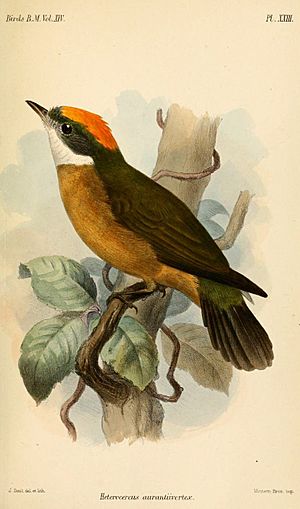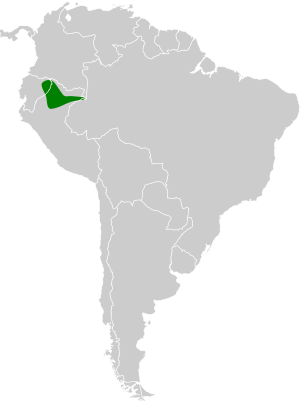Orange-crested manakin facts for kids
Quick facts for kids Orange-crested manakin |
|
|---|---|
 |
|
| Illustration by Joseph Smit, 1881 | |
| Conservation status | |
| Scientific classification | |
| Genus: |
Heterocercus
|
| Species: |
aurantiivertex
|
 |
|
The orange-crested manakin (Heterocercus aurantiivertex) is a small, colorful bird. It is part of the Pipridae family, also known as the manakin family. You can find this special bird in parts of Ecuador and Peru. It likes to live in wet, swampy areas or dry, shrubby places in tropical regions.
Contents
What is an Orange-crested Manakin?
The orange-crested manakin is a type of passerine bird. This means it is a perching bird, like many songbirds. It is known for its bright orange feathers on its head, which look like a crest. These birds are usually quite small. They are often shy and hard to spot in the wild.
Where do Orange-crested Manakins Live?
These birds live in specific parts of South America. Their main homes are in the countries of Ecuador and Peru. They prefer warm, tropical areas.
Orange-crested Manakin Habitats
The orange-crested manakin lives in two main types of places:
- Swamplands: These are wet, marshy areas with lots of water and plants.
- Dry Shrublands: These are drier areas with many bushes and small trees.
Both of these habitats are found in tropical regions, which means they are warm all year round.
Manakin Behavior and Diet
Manakins are known for their interesting behaviors. Male manakins often perform special dances to attract females. They might jump, slide, or even make buzzing sounds with their wings.
What do Manakins Eat?
Orange-crested manakins mainly eat small fruits. They also sometimes eat insects. They find their food by moving quickly through the trees and bushes in their habitat.
Conservation Status
The orange-crested manakin is listed as "Least Concern" by the International Union for Conservation of Nature (IUCN). This means that, for now, their population is stable. They are not currently at high risk of disappearing. However, it is always important to protect their natural homes.
See also

- In Spanish: Saltarín crestinaranja para niños


